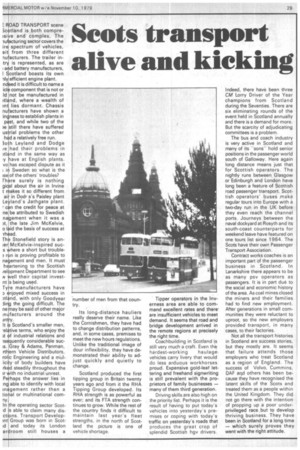Scots transport alive and kicking
Page 31

If you've noticed an error in this article please click here to report it so we can fix it.
ER OAD TRANSPORT scene tland is both compre'Si e and complex. The lu turing sector covers the ir spectrum of vehicles, eit from three different nu acturers. The trailer inis represented, as are a d battery manufacturers, cotland boasts its own efficient engine plant.
nd ed it is difficult to name a idl component that is not or Id not be manufactured in itl nd, where a wealth of in lies dormant. Chassis nu acturers have shown a in ness to establish plants in st, and while two of the P.e still there have suffered us trial problems the other hcd a relatively free run.
lo h Leyland and Dodge ie had their problems in )t1 nd in the same way as
have at English plants. ; vo
ii. has escaped dispute as it Sweden so what is the of the others troubles?
ise fh re surely is nothing gicsal about the air in Irvine t makes it so different from air in Dodr e's Paisley plant Leyland's 3athgate plant.
• can the credit for peace at ne: be attributed to Swedish nagement when it was a )t,. the late Jim McKelvie, o laid the basis of success at 1-1 Stonefield story is anier McKelvie-inspired sucs vhere a short but troublerim is proving profitable to nagernent and men. It must heartening to the Scottish /el prnent Department to see rv ell their capital investnt s being used.
Ty e manufacturers have 3 njoyed mixed success in )t1 nd, with only Goodyear
the going difficult. The ne ay be said of other major in facturers around the in It i Scotland's smaller men, • tive terms, who enjoy the
f industrial relations and Iseiquently considerable sucs. Gray & Adams, Penman, rthern Vehicle Distributors, relic Engineering and a midlcity of body builders have rked steadily throughout the ir with no industrial unrest. Perhaps the answer lies in rig able to identify with local inagement rather than a tio al or multinational cornny In he operating sector Scot id able to claim many dis ct ons. Transport Developint Group was born in Scotid and today its London ar room still houses a
'number of men from that country.
Its long-distance hauliers really deserve their name. Like the Cornishmen, they have had to change distribution patterns, and, in some cases, premises to meet the new hours regulations. Unlike the traditional image of dour inflexibility, they have demonstrated their ability to adjust quickly and quietly to change.
Scotland produced the first tipping group in Britain twenty years ago and from it the RHA Tipping Group developed. Its RHA strength is as powerful as ever; and its FTA strength continues to grow. While the rest of the country finds it difficult to maintain last year's fleet strengths, in the north of Scotland the picture is one of vehicle shortage. Tipper operators in the Inverness area are able to command excellent rates and there' are insufficient vehicles to meet demand. It seems that road and bridge development arrived in the remote regions at precisely the right time.
Coachbuilding in Scotland is still very much a craft. Even the hardest-working haulage. vehicles carry livery that would do less arduous workhorses proud. Expensive gold-leaf lettering and freehand signwriting is still prevalent with the proprietors of family businesses — many of them third generation.
Driving skills are also high on the priority list. Perhaps it is the result of having to put today's vehicles into yesterday's premises or coping with today's traffic on yesterday's roads that produces the great crop of splendid Scottish hgv drivers. Indeed, there have been three CM Lorry Driver of the Year champions from Scotland during the Seventies. There are six eliminating rounds of the event held in Scotland annually and there is a demand for more. But the scarcity of adjudicating committees is a problem.
The bus and coach industry is very active in Scotland and many of its -sons" hold senior positions in the passenger world south of Galloway. Here again long distance means just that for Scottish operators. The nightly runs between Glasgow or Edinburgh and London have long been a feature of Scottish road passenger transport. Scottish operators' buses .make regular tours into Europe with a two-day run in the UK before they even reach the channel ports. Journeys between the naval dockyard at Rosyth and its south-coast counterparts for weekend leave have featured on one tours list since 1964. The Scots have their own Passenger Transport Association.
Contract works coaches is an important part of the passenger business in Scotland. In Lanarkshire there appears to be as many psv operators as passengers. It is in part due to the social and economic history of the area. As coal mines closed the miners and their families had to find new employment. After generations in small communities they were reluctant to uproot, so the new employers provided transport, in many cases, to their factories.
Not all the transport histories in Scotland are sOccess stories, but they mostly are. It seems that failure attends those employers who treat Scotland as a region of England. The success of Volvo, Cummins, OAF and others has been because they have recognised the latent skills of the Scots and treated them as a people within the United Kingdom. They did not go there with the intention of propping up a poor under privileged race but to develop thriving business. They have been in Scotland for a long time — which surely proves they went with the right attitude.












































































































































































































































